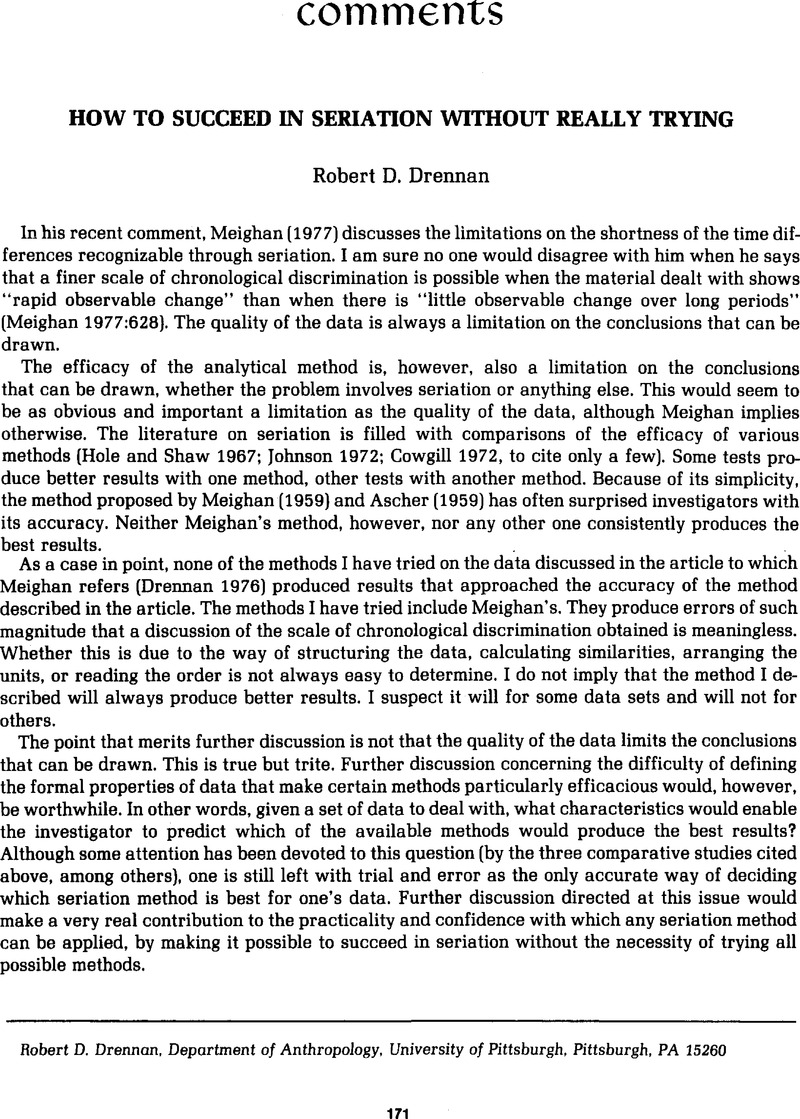No CrossRef data available.
Article contents
How to Succeed in Seriation without Really Trying
Published online by Cambridge University Press: 20 January 2017
Abstract
An abstract is not available for this content so a preview has been provided. Please use the Get access link above for information on how to access this content.

- Type
- Comments
- Information
- Copyright
- Copyright © The Society for American Archaeology 1979
References
References Cited
Ascher, Marcia
1959
A mathematical rationale for graphical seriation.
American Antiquity
25:212–214.Google Scholar
Cowgill, George L.
1972
Models, methods, and techniques for seriation.
In Models in archaeology, edited by Clarke, David L., pp. 381–424. Methuen, London.Google Scholar
Drennan, Robert D.
1976
A refinement of chronological seriation using nonmetric multidimensional scaling.
American Antiquity
41:290–302.Google Scholar
Hole, Frank, and Shaw, Mary
1967
Computer analysis of chronological seriation.
Rice University Studies
53(3).Google Scholar
Johnson, Le Roy Jr.
1972
Introduction to imaginary models for archaeological scaling and clustering.
In Models in archaeology, edited by Clarke, David L., pp. 309–380.Methuen, London.Google Scholar
Meighan, Clement W.
1959
A new method for the seriation of archaeological collections.
American Antiquity
25:203–211.CrossRefGoogle Scholar
Meighan, Clement W.
1977
Recognition of short time periods through seriation.
American Antiquity
42:628–629.Google Scholar
Conover, W. J.
1974
Some reasons for not using the Yates continuity correction on 2 x 2 contingency tables.
Journal of the American Statistical Association
69:374–376.Google Scholar
Grizzle, J. E.
1967
Continuity correction in the x Mest for 2 x 2 tables.
The American Statistician
28:28–32.Google Scholar
Lovis, W. A.
1976
Quarter sections and forests: an example of probability sampling in the northeastern woodlands.
American Antiquity
41:364–372.Google Scholar
Mueller, J. W.
1975
Archaeological research as cluster sampling.
In Sampling in archaeology, edited by Mueller, James W., pp. 33–41. University of Arizona Press, Tucson.Google Scholar
Plackett, R. L.
1964
The continuity correction in 2 x 2 tables.
Biometrika
51:327–337.Google Scholar
Thomas, D. H.
1975
Non-site sampling in archaeology: up the creek without a site?
In Sampling in archaeology, edited by Mueller, James W., pp. 61–81. University of Arizona Press, Tucson.Google Scholar




